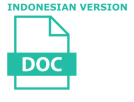Kolokasi Bahasa Inggris dalam Tugas Akhir Mahasiswa: Analisis Berbasis Frekuensi dengan Google sebagai Korpus
Tri Nuraniwati(1*), Ashfa F Lathifah(2)
(1) Universitas Gadjah Mada
(2) Sekolah Vokasi Universitas Gadjah Mada
(*) Corresponding Author
Abstract
This study aims to analyze the search results’ frequency of collocations used by students of English Program, Vocational College UGM in their graduating papers (Tugas Akhir) and to show how Google can be used as a practical online corpus for collocations query. Collocations are words that co-occur together in any text and have fixed association. The use of collocations is part of linguistic awareness which determines how language is used in its natural state. Through corpus-based analyses, 1000 collocations are randomly chosen from 10 graduating papers (100 collocations per graduating paper). Using Google search engine, each collocation is entered as key words to find out the frequency of its search hits. The frequency is subsequently categorized into high frequency, medium frequency, and low frequency. From the 1000 collocations, 802 (80.2%) collocations belong to high-frequency collocations, 120 (12%) collocations are in the category of medium frequency, and 78 (7.8%) collocations are categorized as low-frequency collocations. The results indicate that students have shown good level of accuracy in using collocations in their academic writing.
Keywords
Full Text:
PDFReferences
Anderson W. & J. Corbett. (2009). Exploring English with Online Corpora: An Introduction. London: Palgrave.
Corpus. (2017) http://dictionary.cambridge.org/dictionary/english/corpus
Fan, May. (2009). An Exploratory study of collocational use by ESL students—A task based approach. System, 37, 110-123.
Fletcher, William. (2002). Making the Web More Useful as a Source for Linguistic Corpora. Corpus Linguistics in North America 2002: Selections from the Fourth North American Symposium of the American Association for Applied Corpus Linguistics. http://kwicfinder.com/AAACL2002whf.pdf Accessed 16.04.13
Gabrielatos, Constatinos. (1994). Collocations: Pedagogical implications and their treatment in pedagogical materials. Unpublished essay. Research Centre for English and Applied Linguistics. University of Cambridge.
Kennedy, Graeme. (2003). Amplifier Collocations in the British National Corpus: Implications for English Language Teaching. TESOL Quarterly 37 (3), 467-477.
McEnery, Tony, et al. (2016). Corpus-Based Language Studies: An Advanced Resource Book. London: Routledge.
Meyer, Charles F. (2002). English Corpus Linguistics: An Introduction. Cambridge: CUP.
Prensky, Marc. (2012) From Digital Natives to Digital Wisdom: Hopeful Essays for 21st Century Education. http://marcprensky.com/writing/Prensky-Intro_to_From_DN_to_DW.pdf
Romer, U. (2008) Corpora and language teaching. In A. Ludeling & M. Kyoto (Eds.), Corpus linguistics: An international handbook (Vol. 1, pp. 112-130). Berlin:nMouton de Gruyter.
Shaw, Erin. (2011). Teaching Vocabulary Through Data-driven Learning. Idaho: BYU.
Article Metrics
Refbacks
- There are currently no refbacks.
Copyright (c) 2018 The Author(s)

This work is licensed under a Creative Commons Attribution-ShareAlike 4.0 International License.








